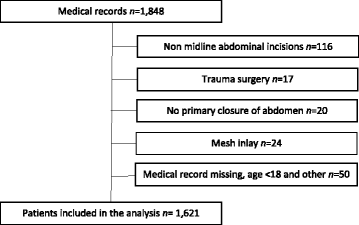Retrospective review of risk factors for surgical wound dehiscence and incisional hernia
- PMID: 28222776
- PMCID: PMC5320761
- DOI: 10.1186/s12893-017-0207-0
Retrospective review of risk factors for surgical wound dehiscence and incisional hernia
Abstract
Background: Several factors and patient characteristics influence the risk of surgical wound dehiscence and incisional hernia after midline laparotomy. The purpose of this study was to investigate whether a specified, or not specified, suture quota in the operative report affects the incidence of surgical wound complications and to describe the previously known risk factors for these complications.
Methods: Retrospective data collection from medical records of all vascular procedures and laparotomies engaging the small intestines, colon and rectum performed in 2010. Patients were enrolled from four hospitals in the region Västra Götaland, Sweden. Unadjusted and adjusted Cox regression analyses were used when calculating the impact of the risk factors for surgical wound dehiscence and incisional hernia.
Results: A total of 1,621 patients were included in the study. Wound infection was a risk factor for both wound dehiscence and incisional hernia. BMI 25-30, 30-35 and >35 were risk factors for wound dehiscence and BMI 30-35 was a risk factor for incisional hernia. We did not find that documentation of the details of suture technique, regarding wound and suture length, influenced the rate of wound dehiscence or incisional hernia.
Conclusions: These results support previous findings identifying wound infection and high BMI as risk factors for both wound dehiscence and incisional hernia. Our study indicates the importance of preventive measures against wound infection and a preoperative dietary regiment could be considered as a routine worth testing for patients with high BMI planned for abdominal surgical precedures.
Keywords: Hernia; Laparotomy; Risk factors; Surgical wound dehiscence.
Similar articles
-
Introduction of Small Stitch Small Bite technique: a retrospective long-term follow-up.Langenbecks Arch Surg. 2022 Sep;407(6):2527-2535. doi: 10.1007/s00423-022-02530-8. Epub 2022 May 17. Langenbecks Arch Surg. 2022. PMID: 35577975 Free PMC article.
-
Wound complications after primary and repeated midline, transverse and modified Makuuchi incision: A single-center experience in 696 patients.Medicine (Baltimore). 2021 May 21;100(20):e25989. doi: 10.1097/MD.0000000000025989. Medicine (Baltimore). 2021. PMID: 34011091 Free PMC article.
-
Protocol for a randomized controlled trial comparing wound COmplications in elective midline laparotomies after FAscia Closure using two different Techniques Of Running sutures: COFACTOR trial.Trials. 2020 Jul 2;21(1):608. doi: 10.1186/s13063-020-04507-8. Trials. 2020. PMID: 32616017 Free PMC article.
-
Prevention of incisional hernias: how to close a midline incision.Surg Clin North Am. 2013 Oct;93(5):1027-40. doi: 10.1016/j.suc.2013.06.009. Surg Clin North Am. 2013. PMID: 24035074 Review.
-
[Current standards of abdominal wall closure techniques : Conventional suture techniques].Chirurg. 2016 Sep;87(9):737-743. doi: 10.1007/s00104-016-0231-0. Chirurg. 2016. PMID: 27392763 Review. German.
Cited by
-
The Effect of Fascial Closure With Triclosan-Coated Sutures on the Incidence of Abdominal Wall Dehiscence: An Individual Participant Data Meta-Analysis.J Abdom Wall Surg. 2024 Sep 18;3:13337. doi: 10.3389/jaws.2024.13337. eCollection 2024. J Abdom Wall Surg. 2024. PMID: 39360221 Free PMC article. Review.
-
Rectus diastasis increases risk of burst abdomen in emergency midline laparotomies: a matched case-control study.Hernia. 2023 Apr;27(2):353-361. doi: 10.1007/s10029-022-02719-2. Epub 2022 Nov 23. Hernia. 2023. PMID: 36422726
-
Introduction of Small Stitch Small Bite technique: a retrospective long-term follow-up.Langenbecks Arch Surg. 2022 Sep;407(6):2527-2535. doi: 10.1007/s00423-022-02530-8. Epub 2022 May 17. Langenbecks Arch Surg. 2022. PMID: 35577975 Free PMC article.
-
Incisional hernia at the site of stoma reversal-incidence and risk factors in a retrospective observational analysis.Int J Colorectal Dis. 2019 Jul;34(7):1179-1187. doi: 10.1007/s00384-019-03310-5. Epub 2019 May 7. Int J Colorectal Dis. 2019. PMID: 31065787
-
Incisional hernia rates between intracorporeal and extracorporeal anastomosis in minimally invasive ileocolic resection for Crohn's disease.Langenbecks Arch Surg. 2023 Jun 29;408(1):251. doi: 10.1007/s00423-023-02976-4. Langenbecks Arch Surg. 2023. PMID: 37382678
References
-
- Gislason H, Gronbech JE, Soreide O. Burst abdomen and incisional hernia after major gastrointestinal operations--comparison of three closure techniques. Eur J Surg. 1995;161(5):349–54. - PubMed
MeSH terms
LinkOut - more resources
Full Text Sources
Other Literature Sources
Medical


